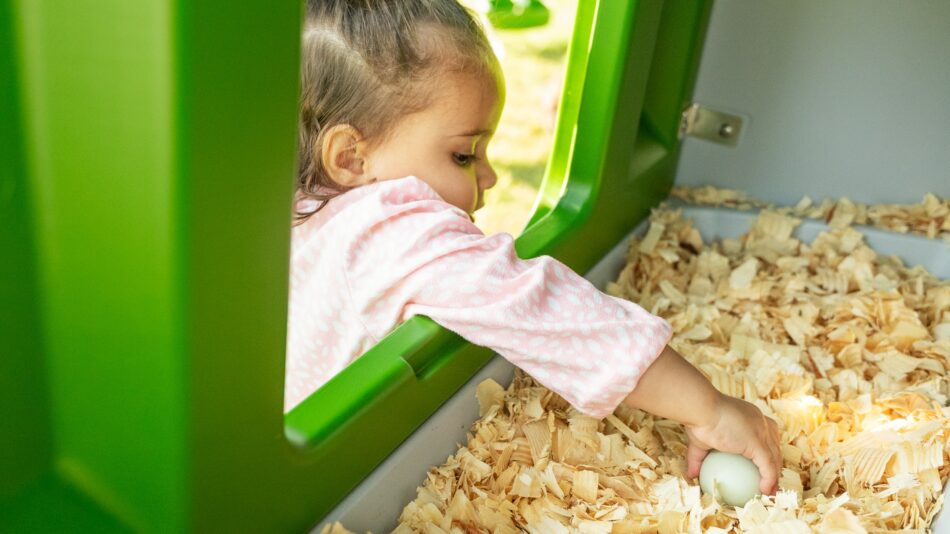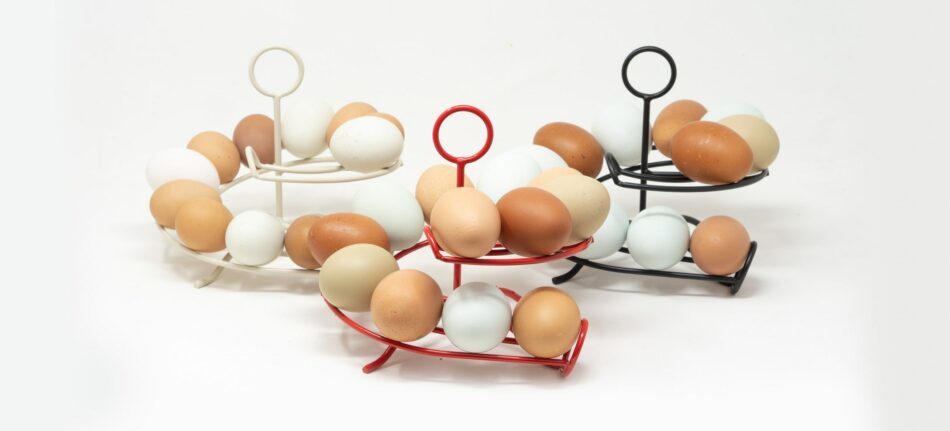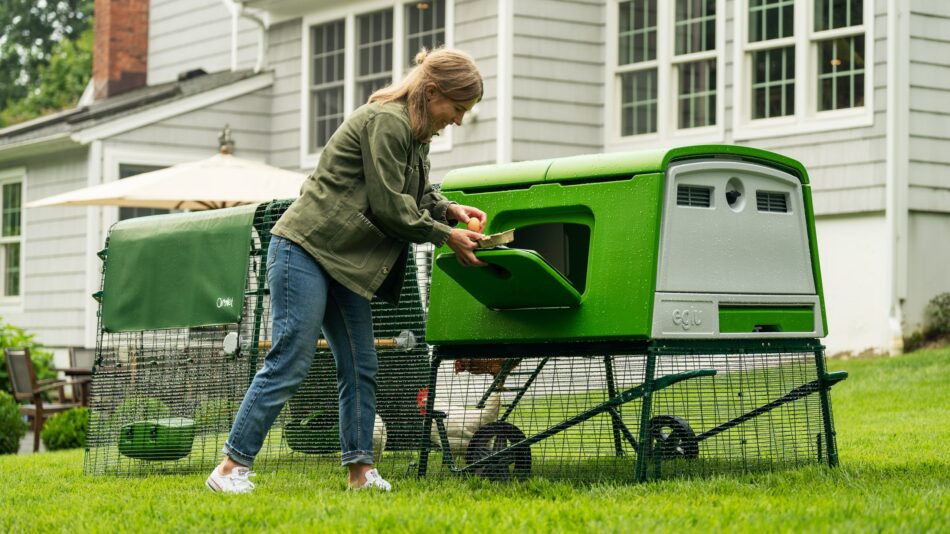What are your hens’ eggs telling you?
Eggs are amazing, nutritious feats of nature that chickens give back to their keepers. They come in a variety of sizes, colours, and sometimes even shapes, but sometimes their appearance can surprise those who come to collect them. From the normal to the not-so-normal, we’ll cover it all in our What are your hens’ eggs telling you? guide.
Why are chicken eggs sometimes misshapen?
An oddly shaped egg can be produced for various reasons. It often takes young hens an egg or two before they settle into their regular pattern. Stress in the chicken coop can lead to misshapen eggs too. This is usually due to a hen having the urge to lay but finding the space in the laying box occupied by another bird.
Misshapen eggs can be:
- Elongated, or they may have a thin, pointy end.
- Rough with bumps
- Thicker around the middle, appearing in a band pattern
- Round rather than the traditional oblong appearance
A ball-shaped egg is usually a sign of slight calcium deficiency. The round shape requires less calcium than a normal oval egg. In all these cases, the egg inside is unaffected and is perfectly safe to eat.
Infectious bronchitis can lead to misshapen eggs. An infected hen will stop producing eggs for a few days or will only lay intermittently. The eggs that are laid will have thin, wrinkled or rough shells, and the white of the egg will be watery. It is also common for the affected eggs to have lighter-coloured shells than usual. This condition is uncommon, and should be diagnosed by a veterinarian.
Laryngotracheitis is another illness linked to egg abnormalities, but should also be diagnosed by a veterinarian. It’s important to note that any ailment can cause a hen to become stressed, which can cause a hen to lay misshapen eggs.
Why do chickens lay freckled eggs?
Some breeds always lay speckled eggs. However, if a hen that typically produces plain eggs lays speckled ones, there are various possible causes. She may have been stressed in some way while the egg was forming, or she may have developed an anomaly in the pigment-producing part of her egg-laying system.
Freckling is often the result of excess calcium production, sometimes associated with the ‘end of season’ laying at the beginning of winter. On some eggs, there is a marbled pattern rather than an area of freckles.
The speckling is usually smooth, but it sometimes manifests as raised blotches of excess calcium. These can be spots or wormlike strands, and they often occur as single spots on an otherwise standard egg. This may be linked to dehydration, so make sure your hens have enough water, and that a timid hen isn’t being bullied out of being properly hydrated.
Why do chicken eggshells sometimes have a white ring?
Viewed from the side, an eggshell with this peculiar oddity has a thick white ring, looking like an x-ray of the egg that lies beneath. It is usually caused by an interruption in the formation of the eggshell, caused by stress or by a second egg entering the internal production line.
The second egg produced in this process will usually have a flattened side, as it has bumped into the first egg during the early stages of shell formation and has been ‘squashed’ into an odd, flattened shape.
Why are chicken eggs sometimes wrinkled?
An eggshell with wrinkles can be a sign of stress or illness, but is usually a hereditary condition. Some older hens begin to lay wrinkled eggs too. The wrinkles are often deep grooves, giving the appearance of a very misshapen egg that is perhaps the most unusual of all egg oddities.
The wrinkles sometimes look like a series of cracks in the shell. This results from an egg cracking during calcium formation. The cracks are the chicken’s repairs – laying calcium over the fissures. Once again, the underlying cause is usually stress or illness, although sometimes it is simply the result of a second egg ‘crashing into’ the first due to an over-productive system.
Why do some eggs have double yolks?
In a rare, but completely normal phenomenon, chickens can lay eggs with two yolks inside. If fertilized and incubated or kept under a broody hen, double-yolked eggs can hatch twin chicks – but it’s more common for only one embryo to fully develop.
If you crack one of your chickens’ eggs and see two yolks, it’s the result of the hen releasing two yolks at the same time during ovulation, which then becomes encapsulated within one shell. It’s more common for newly-matured hens to lay double-yolked eggs, as their bodies are adjusting to ovulation. Laying eggs with two yolks can also be genetic, and the hen may continue to do so for the duration of her egg-laying career.
You do not need to crack the shell to find out what is inside – you can spot a double-yolker by ‘candling’ the egg. The word candling comes from the ancient practice of holding an egg in front of a candle flame, but a small flashlight does the job just as well. If there are two yolks inside, they will be visible as two dark blobs against the bright light as it shines through the shell.
Although double-yolkers are estimated to occur in just one per thousand eggs, the huge population of laying hens over the world means that they are a common sight on the plates of chicken keepers. Triple yolks are possible, but are very unlikely to grace the breakfast table– this ultra-rare phenomenon is found in just one per 25 million eggs.
Why do chickens lay less eggs sometimes?
Breed, age, health, and time of year all affect how many eggs chickens lay. Among the many different chicken breeds that are considered good layers (those that can lay upwards of 300 eggs per year), some well-known egg producers include:
- Rhode Island Reds
- Australorps
- Leghorns
- Marans
- Ameraucanas
- Orpingtons
In contrast, most ornamental and smaller chicken breeds lay less frequently, with some only laying a few eggs each month.
Depending on their genetics, hens will begin to ovulate (release a yolk) every 24 hours on average, starting at 6 months of age. Once a yolk has been released, it takes 19-20 hours to finish forming and be fully dressed in an eggshell. After an egg has been laid, the process repeats again – good layers can begin ovulating again within an hour after laying an egg. A hen will lay the most eggs during the first two years of life. After that, production begins to decrease by 10-20% each year.
Hens that are not feeling well, or are malnourished will lay less frequently. Flock discord, inadequate nutrition, and overcrowding are a handful of stressors that can take a toll on egg production. Make sure your hens have access to clean water and quality layer pellets at all times to ensure they’re getting the calories and nourishment they need. Adding scratch grains, chicken treats, and healthy kitchen scraps or safe foods from the garden to their diet will also give hens a nutritional boost.
Hens will inevitably lay less, or stop laying eggs altogether in the winter. A hen’s ovulation cycle is based on daylight hours, so once the days shorten, you can expect egg production to slow down. This is a hen’s natural reaction to the changing seasons as they prepare to reallocate energy to keep warm instead of laying eggs. Your hens will resume a normal laying schedule closer to spring, as days grow longer.
Another annual reason for a decrease in egg production is moulting. Moulting is the process of shedding old feathers and regrowing new ones to replace them. Moulting also occurs during the fall in preparation for winter – so as the days grow shorter, your hens will begin to lose their dingy feathers in favour of new, denser ones to keep them warm. The result is a beautiful, vibrant new feathery outfit for your hens – but fewer eggs for you to gather. Moulting takes a lot of energy, so expect your chickens to be on “lay-cation” for 8-16 weeks. There are some things you can do to help your chickens through a molt to offer relief during your flock’s annual feather renewal.
Why do chicken breeds lay different-coloured eggs?
You’ve probably seen white and brown eggs, but some chickens can lay eggs in shades of green, blue, and even pink. But what causes such a variety of colours?
Genetics determine what colour eggs a hen will lay. Some breeds of chickens have a standard colour you can expect from them. For example, you can count on Leghorns to lay white eggs, Orpingtons to lay brown eggs, and Ameraucanas to lay blue ones. But different shades such as olive are the result of a hybrid hen – a hen bred from a combination of blue and brown egg genes. For example, if you breed an Orpington (brown egg genetics) cockerel with an Ameraucana (blue egg genetics) hen, the result would be an “olive egger” hen that would lay green eggs. Egg colour should be consistent with the hen laying them, and different-coloured eggs are not a cause for concern unless a hen suddenly starts laying a different shade from usual.
All eggs begin with a white shell, but the hen laying the egg adds a pigment to them as they make their way to be laid. This pigment only colours the shell, and does not penetrate the membrane. You’ll have to add food colouring if you want green eggs and ham!
Other breeds known for laying colourful eggs include: Rhode Island Reds, Plymouth Rocks, Wellsummers, and Marans. Hybrids (bred through selective pairing), such as Olive or Easter Eggers, can produce eggs varying in colour based on their genetics.
Pro tip: you can get an idea of the colour eggs a hen lays by looking at their earlobes. Hens with white earlobes will lay white eggs, and hens with red earlobes will lay brown eggs. This technique is not as accurate for pigmented eggs (blue, green or pink), as hybrid chickens will have a variety of colours to their earlobes. Still, it’s fun to try this prediction test with your flock.
Why do my chickens’ eggs have a thin shell, or no shell at all?
Have you ever collected eggs, only to find yourself flabbergasted by a naked egg? Thin-shelled eggs or those with no shell at all feel like partially filled water balloons and can be very disconcerting to find in the nesting box. These strange, spongy eggs are actually laid without the presence of the shell; only the membrane. This most often occurs with high-producing hens, when their bodies simply cannot keep up with yolk production. Oftentimes they will lay a fully-formed egg, then lay a shell-less egg a few hours later.
The other most common reason for eggs having thin or missing shells is inadequate calcium in their diet. Warning signs leading up to shell-less eggs can be thinner shells, so take note if your hens’ eggs are suddenly much easier to crack, or if you find broken eggs in the nesting box. A lot of calcium is required to “fully clothe” a yolk, so be sure to feed quality layer pellets that contain added calcium. If you notice thinner shells or “naked” eggs, supplement your hens’ feed with crushed oyster shells or other chicken calcium supplements. You can also save egg shells after cracking them to crush or grind up and sprinkle on top of your hens’ feed. Be sure not to offer shells that have not been broken down into smaller pieces, as chickens can acquire a taste for eggs and can actually eat them straight out of the nesting box.
Boost your hens’ shell-producing ability with chicken supplements to ensure they have all of the vitamins and minerals they need. As an added bonus, supplements such as omega-3 fed to your chickens are passed onto their eggs– and then to you when you eat them!
Why do chickens sometimes eat their eggs?
Hens will actually eat their own eggs, usually for specific reasons. This behaviour can usually be corrected when adjustments are made to their environment.
Dehydration
Chickens that eat their eggs may be dehydrated. Since eggs contain a large amount of water, your chickens may be resorting to eating them in an effort to keep themselves hydrated. To stop egg eating due to dehydration, make sure that your hens are supplied with clean water at all times.
Vitamin deficiency
Your chicken’s diet is fundamental to their well-being, and a poor one could be depriving them of their nutritional requirements – leading them to feast on their eggs in an effort to recoup missing nutrients. It’s important to provide your chickens with a balanced diet of enough protein, carbohydrates, vitamins, and minerals. For added calcium, offer crushed oyster shells.
Issues with the nesting box
Your nesting box needs to be a secure and safe space for your hens. Egg eating can occur when your hens are uncomfortable with the nesting box, most commonly due to the bedding itself or exposing your chickens to too much light. Make sure that their nesting area:
- Has adequate bedding made of a comfortable nesting material
- Remains free of droppings or debris
- Does not receive direct sunlight
- Has enough space for the number of hens you keep
- Is completely separate from the roosting area
Our chicken coops are designed for easy cleaning, and with integrated and private nesting boxes, while leaving plenty of space for roosting. This ensures a comfortable and hygienic habitat for your hens that will support them in their laying efforts.
Behavioural
Chickens found to be eating eggs can also be suffering from stress or anxiety, which hens can experience for a number of reasons. Stress-inducing scenarios can be related to:
- Being handled
- A new environment
- The introduction of new chickens
- Extreme heat
- Visits from predators
Some stressful situations are easier to alleviate than others, such as introducing new chickens or excessive handling.
Chickens that eat eggs may simply be bored. Boredom in chickens can occur when they don’t have enough space to roam, or they lack activities to keep them entertained.
For a happy hen, provide as much space as possible outside of the coop with a walk in chicken run or chicken fencing. Chicken toys are another great way to keep your chickens entertained.
Omlet and your hens’ eggs
The more love and care you put into your flock’s setup and your interactions with them, the happier and healthier your hens will be – and the more delicious and healthy their eggs will be. Hens that are kept in clean, safe chicken coops will lay eggs more regularly and without difficulty. The joy and companionship you’ll reap from sowing a great relationship with your hens will accompany the steady supply of eggs for you to display in your kitchen – a visual reminder of the bond you share with your flock.
This entry was posted in Chickens


